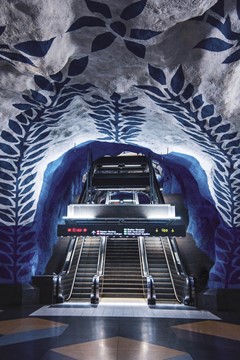Stockholm on a shoestring budget
In general, Stockholm is not known to be a very budget-friendly city, especially when it comes to travelling, food and alcoholic drinks. However, the Swedish capital is a surprisingly easy to manage on a low budget if you know how, covering nature, culture and food and drinks. Here are our top six tips for a trip to Stockholm on a shoestring.
Take a free walking tour through Gamla stan
 Stockholm’s Old Town, the Gamla stan, dates back to the 13th century when the first houses were built here on the island of Stadsholmen. Here, you can wander around and discover the heart of the city and its origins. Some of the most famous attractions include the Royal Palace, the Tyska kyrkan (German Church), reminding visitors of the time when half of Stockholm’s population was actually German, as well as the Storkyrkan. Explore narrow alleys, marvel at the colourful houses and discover small restaurants and galleries.
Stockholm’s Old Town, the Gamla stan, dates back to the 13th century when the first houses were built here on the island of Stadsholmen. Here, you can wander around and discover the heart of the city and its origins. Some of the most famous attractions include the Royal Palace, the Tyska kyrkan (German Church), reminding visitors of the time when half of Stockholm’s population was actually German, as well as the Storkyrkan. Explore narrow alleys, marvel at the colourful houses and discover small restaurants and galleries.
Free walking tours are the perfect way to discover the city without spending too much money and learning something about it too. The one and a half to two hours long tours around Stockholm’s Old Town guide you through Stockholm’s most famous area. Wander through the narrow alleyways and cobblestone streets and learn all about Stockholm’s history-charged past full of Vikings, ghosts and royalty at the same time. Depending on how much you liked the walking tour, you can tip your tour guide.
Take advantage of lunchtime
Eating out in Sweden’s capital is expensive. While Sweden’s taxes for food and drinks are quite high compared to other European countries, there’s an easy way around this: daily lunch deals, locally known as Dagens Rätt or Dagens Lunch.
Just keep an eye out for the restaurant’s signs just in front of the door or in the windows. The dishes of the day are served at much more affordable prices than during dinner time. At lot of cafes and restaurants, this includes coffee as well as bread with butter and sometimes even a fresh salad.

Take a stroll through the nearby nature
Another low budget activity is exploring Stockholm’s many parks. Did you know that more than two thirds of the city are made up of water or green spaces? Stockholmers love to spend time outside, especially in Hagaparken and Djurgården, the city’s most beloved parks. Depending on the season you’re visiting in, you can even stroll through the blooming cherry trees at Kungsträdgården, the King’s Garden.
Skinnarviksberget is Stockholm’s highest natural point with 53 meters above sea level and guarantees a magnificent view over the city, If you climb Skinnarviksberget, you can see the Old Town, Kungsholmen as well as some points of interests like Stockholm City Hall. And the best part is that escaping the hustle and buzzle of the city to this quaint and peaceful area is an wonderful low budget activity all-year round.
Free museums
While the entry to some of Stockholm’s best museums such as the ABBA museum or the Vasa museum are relatively pricey, there are a few museums that you can enter for free. This initiative from the Swedish government covers some of the country’s most popular museums that are owned by the state.
This includes popular attractions such as the Moderna Museet, Stockholm’s museum for modern and contemporary art from Sweden and the whole world, the Nationalmuseum where you can find paintings, sculptures and drawings from the 15th to 19th century, or the National Museums of World Culture that consists of three museums in Stockholm alone and gives you a glimpse into other and cultural variation – be it historical or modern, national or international.
Stockholm subway art

Rumor has it that Stockholm’s 110 kilometres long subway system is the longest art exhibition in the world. Travelling by metro not only takes you from A to B but also on a journey through the 1950s when this artistic experiment was started. Artists have been involved with the design of the stations since 1957. The hundred subway stations charm their frequent visitors and tourists alike with unique designs, beautiful statues, murals and even installations.
Mörby Centrum subway station for example is embedded in colourful tilework that create an optical illusion, symbolizing the journey itself. Solna Centrum on the other side is covered in a luminous green and red landscape – the forest and the red evening sun setting behind the tree’s crowns, addressing deforestation, environmental issues and the decreasing population of rural areas.
